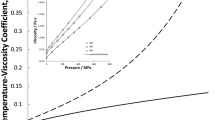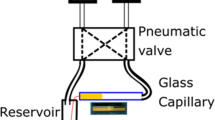Summary
The effect of viscous heating in a capillary rheometer is analysed for a power-law fluid by means of a perturbation expansion based upon a boundary-layer-core structure. This expansion is found to complement the eigenfunction series solution obtained by earlier investigators. A similar analysis is presented for the “work-of-expansion” effect. These two thermal effects are superimposed together with a third perturbation effect due to the pressure dependence of viscosity.
On the basis of the present theory, earlier work in this area is discussed and, in some cases, apparent inaccuracies or inconsistencies are pointed out. A means is indicated for correcting data on the basis of the present theory.
Zusammenfassung
Es wird der Effekt der Erwärmung einer Potenzflüssigkeit infolge viskoser Reibung in einem Kapillar-Rheometer mittels einer Störungsrechnung untersucht, die auf der Unterteilung der Strömung in eine Grenzschicht und einen Kern basiert. Diese Störungsentwicklung ergänzt eine früher von anderen Autoren gefundene Reihenentwicklung mit Hilfe von Eigenfunktionen. Eine ähnliche Untersuchung wird für die thermische Ausdehnungsarbeit durchgeführt. Diese beiden thermischen Effekte sind zusammen einem dritten Störeffekt superponiert, der von der Druckabhängigkeit der Viskosität herrührt.
Aufgrund der vorgelegten Theorie werden verschiedene auf diesem Gebiet früher durchgeführte Arbeiten diskutiert, und es werden in einigen Fällen offensichtliche Ungenauigkeiten und Folgewidrigkeiten aufgedeckt. Schließlich wird eine Methode zur Korrektur von Meßdaten mit Hilfe der vorliegenden Theorie angegeben.
Similar content being viewed by others
Abbreviations
- a :
-
tube radius
- b :
-
\(\frac{1}{\eta }\frac{{\partial \eta }}{{\partial p}}\); evaluated atT 0 andp = 0 when used in perturbation expansion
- C p :
-
specific heat
- f :
-
\( - \bar \Lambda _1 /(\varepsilon \Lambda _0 )\)
- f * :
-
\(\bar \Lambda _1^ * /(\varepsilon \Lambda _0 )\)
- h :
-
defined by eq. [15]
- k :
-
thermal conductivity
- L :
-
tube length
- m :
-
defined by eq. [8]
- m 0 :
-
m(T0, 0)
- n :
-
power-law index
- p :
-
pressure
- Pe:
-
ρ C p W a/k ⋯ Peclet number
- Pr:
-
C pηa/k ⋯ Prandtl number
- Q :
-
volumetric flow rate
- Q 0 :
-
unperturbed value ofQ in specified-Δp formulation
- r :
-
radial coordinate
- Re:
-
ρ W a/η a ⋯ Reynolds number
- T :
-
temperature
- T 0 :
-
inlet temperature
- u :
-
radial velocity component
- u 0 :
-
0 ⋯ unperturbed radial velocity
- w :
-
axial velocity component
- w 0 :
-
α/γW(1 − ζ γ) ⋯ unperturbed axial velocity
- W :
-
Q/(πa 2) ⋯ average axial velocity
- W 0 :
-
Q 0/(πa 2)
- z :
-
axial coordinate
- α :
-
(3n + 1)/n
- α * :
-
\( - \frac{1}{\eta }\frac{{\partial \eta }}{{\partial T}}\); evaluated atT 0 andp = 0 when used in perturbation expansion
- β :
-
41-n
- β * :
-
\( - \frac{1}{\rho }\frac{{\partial \rho }}{{\partial T}}\)
- γ :
-
(n + 1)/n
- \(\dot \gamma \) :
-
\(\left| {\frac{{\partial w}}{{\partial r}}} \right|\) ... shear rate
- \(\dot \gamma _a \) :
-
4W/a ⋯ apparent shear rate
- Δp :
-
total pressure drop
- ΔT :
-
η a W 2/k ⋯ characteristic temperature difference
- ΔT b :
-
total bulk-temperature rise
- ε :
-
α * ΔT
- ζ :
-
r/a
- η :
-
shear viscosity
- η a :
-
m0 \(\dot \gamma _a^{n - 1} \)
- κ :
-
(1 −ζ)/ζ 1/3
- Λ :
-
—∂p/∂z
- Λ 0 :
-
\(2\alpha ^n \frac{{m_0 }}{a}\left( {\frac{W}{a}} \right)^n \) ... unperturbed value ofΛ
- \(\bar \Lambda \) :
-
z-averaged value ofΛ
- µ :
-
β α n + 1/n
- ξ :
-
z/(a Pe)
- ξ L :
-
L/(a Pe)
- ρ :
-
mass density
- τ w :
-
shear stress at wall
- ψ :
-
streamfunction
- ω :
-
β *T0 (absolute temperature scale)
- ( )1 :
-
leading-order effect due to viscous heating
- ( ) *1 :
-
leading-order effect due to work-of-expansion
References
Galili, N., R. Takserman-Krozer, Z. Rigbi, Rheol. Acta14, 550 and 816 (1975).
Brinkman, H. C., Appl. Sci. Res.A 2, 120 (1951).
Bird, R. B., S.P.E.J.11, 35 (1955).
Toor, H. L., Trans. Soc. Rheol.1, 177 (1957).
Gerrard, J. E., F. E. Steidler, J. K. Appeldoorn, I.E.C. Fund.4, 332 (1965) and5, 260 (1966).
Choi, S. Y., N. Nakajima, Fifth Int. Congr. Rheol.4, 287 (1970).
Cox, H. W., C. W. Macosko, S.P.E. Antec32, 28 (1974).
Duvdevani, I. J., I. Klein, S.P.E.J.23 (12), 41 (1967).
Kamal, M. R., H. Nyun, Trans. Soc. Rheol.17, 271 (1973).
Nyun, H., Ph. D. Thesis, McGill University (1973).
Cox, H. W., C. W. Macosko Amer. Ind. Chem. Engg. J.20, 785 (1974).
Semjonow, V. Rheol. Acta4, 133 (1965).
Author information
Authors and Affiliations
Additional information
Note: in specified-Δp formulation,W gets replaced byW 0 in definition of Pe, Re,\(\dot \gamma _a \) andξ.
With 7 figures and 7 tables
Rights and permissions
About this article
Cite this article
Hieber, C.A. Thermal effects in the capillary rheometer. Rheol Acta 16, 553–567 (1977). https://doi.org/10.1007/BF01525656
Received:
Issue Date:
DOI: https://doi.org/10.1007/BF01525656




